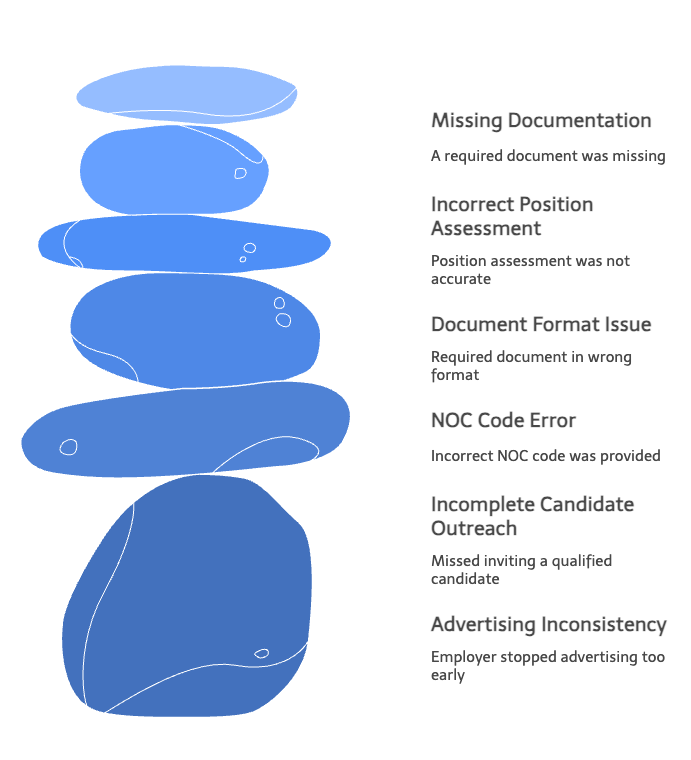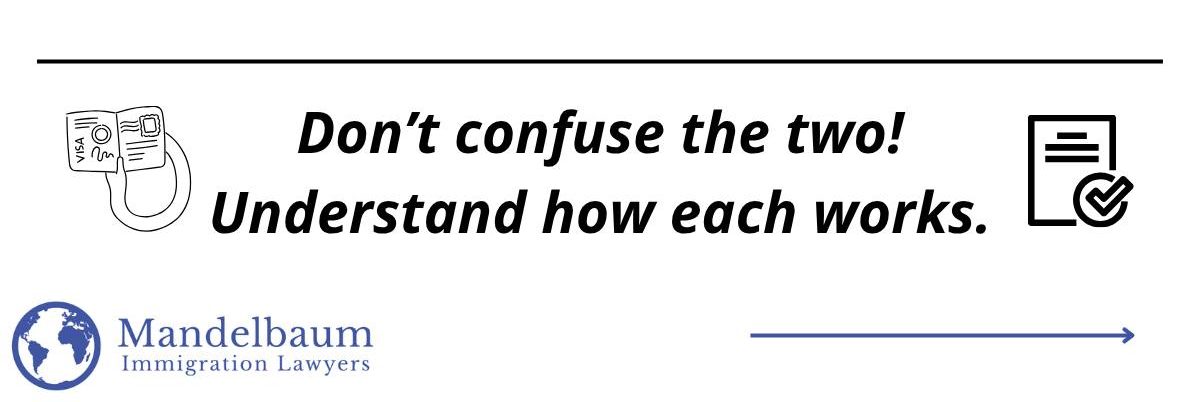Here’s the uncomfortable truth: there are more ways to get an LMIA refused than approved. One mistake – one single oversight – can sink an entire application. Understanding common LMIA rejection reasons isn’t just about diagnosing what went wrong. It’s about preventing rejection in the first place.
This guide walks through the most common LMIA refusal reasons we see, why they happen, and how employers can avoid them. Whether you’re trying to understand why was my LMIA rejected or preparing a new application and don’t want to make costly mistakes, this is your roadmap.
Understanding Common LMIA Rejection Reasons: Why Applications Fail
Reality check: Your LMIA application must be flawless. One mistake – any mistake – can sink it. We’ve seen refusals because:
- The employer stopped advertising two days before the decision
- The employer invited 15 out of 16 Job Bank matches but missed one
- The NOC code was off by one digit
- A required document was submitted in the wrong format
Each step represents a possible refusal ground. Incorrect position assessment? Refused. Advertising ended too early? Refused. Didn’t invite every qualified Canadian to an interview? Refused. Missing one document? Refused.
This isn’t ESDC being unreasonably strict. The Temporary Foreign Worker Program exists to protect Canada’s labour market. The burden is on employers to prove – comprehensively and convincingly – that hiring a foreign worker won’t negatively impact Canadian workers. If you can’t prove it, you don’t get approved.
That’s why understanding required documents and following every procedural requirement matters so much. There’s no room for “I didn’t know” or “I thought that was optional.”

Position Assessment LMIA Rejection Reasons
Before you even start advertising, you need to correctly assess the position. Get this wrong and everything that follows is built on a faulty foundation.
Incorrect NOC Code Identification
Wrong NOC code kills applications constantly.
Example: You think your position is “Marketing Manager” (NOC 10022). ESDC sees “Marketing Coordinator” (NOC 11202). Different NOC = different wage requirements, different stream. Refused.
NOC codes determine:
- What wage you must offer
- Which LMIA stream you qualify for (high-wage vs low-wage)
- What experience and qualifications the foreign worker needs
- What advertising requirements apply
Job duties must align with the NOC code you select. If your job description says “manager” but the actual duties are coordinator-level work, ESDC will catch it. They’re trained to spot NOC misclassification.
Common mistake: Picking the NOC that sounds impressive or has lower wage requirements. Or using the worker’s foreign job title without checking Canadian standards.
Prevention: Match actual job duties to NOC descriptions. Don’t guess. When in doubt, consult an LMIA lawyer.
Wage Offered Below Required Level
Your wage must meet multiple thresholds simultaneously:
- The median wage for that occupation in your region
- The wage you pay existing employees in similar positions
- For high-wage positions, at least 20% above the provincial/territorial median wage
- Any specific wage variations for your industry or occupation
Employers commonly mess this up by:
Looking at the wrong region. You’re hiring for downtown Toronto but checked the median wage for “Ontario” or “Greater Toronto Area” instead of the specific city.
Not accounting for existing employee wages. You offer the foreign worker $25/hour, which is above the median. But you pay your current employees doing the same work $28/hour. Refused. ESDC won’t approve an LMIA that undercuts existing workers.
Ignoring sector-specific rules. Some occupations have unique wage rules. Fee-for-service physicians. Unionized workers. These require careful attention.
Confusing high-wage cutoff with median wage. For a high-wage LMIA, you need at least 20% above the provincial median wage for all occupations. That’s different from the median wage for your specific occupation.
The wage calculation seems straightforward until you actually try to do it. Then you realize there are multiple wage data sources, regional variations, and special rules that all need to align. One miscalculation and months of work goes down the drain.
Wage Below Wages Paid to Similar Workers in Your Workplace
Even if you meet the regional median wage, you still need to ensure the offered wage matches or exceeds what you pay existing employees in similar roles.
ESDC looks at your payroll records. If you’re offering the foreign worker $30/hour but paying current employees doing substantially similar work $32/hour, that’s a problem. The TFW Program isn’t designed to let employers hire cheaper foreign labour. It’s designed to fill genuine labour shortages when Canadians can’t be found.
This trips up employers who think “I’m offering above minimum wage” or “I’m offering the median wage” is enough. It’s not. Internal wage equity matters.
Advertising and Recruitment LMIA Refusal Reasons
Recruitment failures are probably the most common category of LMIA refusal reasons. The advertising and recruitment requirements are detailed, specific, and unforgiving.
Insufficient Advertising Efforts
Advertising requirements for low-wage and high-wage LMIA streams are extensive. You need to advertise:
- Nationally (not just locally)
- On multiple platforms (Job Bank plus at least two other sources)
- For a minimum of four weeks
- With at least one ad running continuously until your LMIA is decided
“Insufficient advertising” means:
Only three weeks advertised. Four complete weeks minimum – no exceptions.
Job Bank plus one source. Not enough. Need Job Bank plus two additional platforms minimum.
Too local. Community Facebook groups or local classifieds don’t count. Must reach Canadians nationally.
Missing information. Job duties, location, wages, employer name, hours – all required. Vague ads = refused.
For high-wage positions especially, ESDC expects significant, broad, and sustained advertising efforts. The program website lists advertising sources as “suggestions,” but employers who do only the bare minimum often find their applications refused for insufficient recruitment.
Advertising Ended Before Decision Was Made
This one catches employers constantly.
You advertised for four weeks. You submitted your LMIA application. The advertising expires. You think “I’m done with advertising now.”
Wrong.
At least one advertisement – typically your Job Bank ad or another national-scope ad – must run continuously from the start of recruitment through to the final LMIA decision. If your ad lapses at any point during processing, your application can be refused.
Why? Because ESDC wants ongoing evidence that you’re still trying to recruit Canadians even while your LMIA is being assessed. Stopping the ads signals that you’re not genuinely interested in hiring Canadians – you just want the foreign worker.
This is particularly brutal for employers whose LMIA takes months to process. You need to keep that advertisement active and keep inviting matched candidates the entire time.
Failure to Invite All Qualified Job Bank Candidates
Job Bank matching is where many good employers trip up.
When you post on Job Bank, the system automatically matches you with candidates and rates them on a star system (1 to 5 stars). How you handle those matches depends on your LMIA stream:
High-wage stream: You must invite all candidates rated 4 stars or higher to apply.
Low-wage stream: You must invite all candidates rated 2 stars or higher to apply.
Miss even one candidate in your required star range and your LMIA can be refused.
Here’s why this is harder than it sounds:
New matches appear throughout processing. You can’t just check once. You need to monitor your Job Bank posting regularly and keep inviting candidates who match your star threshold.
The system updates. Sometimes candidates who were 3-star matches get bumped to 4-star matches as their profiles are updated. You need to catch these changes.
“Invite” means actually sending them an invitation through Job Bank. You can’t just wait for them to apply. You need to proactively reach out.
Employers who don’t understand this requirement, or who stop checking Job Bank once they submit their LMIA application, get refused when ESDC discovers they didn’t invite qualified matches.
Failure to Invite Qualified Canadians to Interviews
Beyond Job Bank, you need to invite any Canadian citizen or permanent resident who meets the advertised requirements to an interview.
“Meets the advertised requirements” is key. If your ad says “3 years experience required” and someone applies with 5 years experience, you must interview them. If your ad says “Bachelor’s degree required” and someone applies with a Master’s degree, you must interview them.
You can’t:
- Screen out overqualified candidates
- Ignore applications because they came in at the last minute
- Skip interviewing people because “they probably won’t accept the offer anyway”
- Refuse to interview someone because they’re currently living far from your location
ESDC reviews your recruitment records. They’ll see who applied, who you interviewed, and who you didn’t. If you skipped qualified Canadians, you’ll need to explain why. And “I didn’t think they’d be a good fit” isn’t going to cut it unless you can point to specific reasons related to the job requirements.
Discrimination and Human Rights Violations in Recruitment
Here’s where immigration law, employment law, and human rights law collide.
You must recruit Canadians first. You cannot discriminate based on nationality or immigration status. These requirements seem contradictory, but you need to navigate both.
Preferential language in your screening notes can sink your application. Things like:
- “Prefer someone who will stay long-term” (could be seen as discriminating against temporary residents)
- “Looking for someone with Canadian experience” (discriminates against new immigrants)
- “Must be comfortable with [specific cultural practice]” (religious or cultural discrimination)
Your interview questions matter too. Asking about immigration status, nationality, or religion during interviews can be used as evidence of discrimination.
If ESDC sees signs of discriminatory hiring practices, they’ll refuse your LMIA. And potentially report your business for human rights violations.
The safe approach? Interview questions should focus exclusively on skills, experience, and ability to perform the job. Document your screening decisions based only on job-related criteria. When in doubt about whether a question or screening practice is discriminatory, consult both an employment lawyer and an immigration lawyer.
Business Eligibility LMIA Rejection Reasons
Your business itself needs to meet certain standards to access the TFW Program.
Cannot Demonstrate Business Legitimacy
Your business must be legally established in Canada and actively doing business – meaning you’re regularly selling goods or services.
Common struggles: New startups with no revenue, sole proprietorships with no employees, businesses without Canadian tax filings, foreign employers without Canadian business presence.
Note: Pre-2024 guidelines for startups were eliminated. Now you need established operations with revenue and employees.
This particularly affects entrepreneurs who want to bring in a key employee to help launch their business. If the business isn’t already established and operating, ESDC may refuse on the grounds that there’s no legitimate business to employ the foreign worker.
Insufficient Financial Capacity
Your business must demonstrate ability to pay the offered wages throughout the entire employment period.
Financial capacity documentation gets scrutinized heavily. ESDC looks at:
- Recent tax filings (T2 schedules for corporations, T2125 for sole proprietorships)
- Profit and loss statements
- Balance sheet and retained earnings
- Payroll records
Red flags that lead to refusal:
- Losses or marginal profits. If your business is losing money or barely breaking even, ESDC questions how you’ll afford another employee.
- Negative or minimal retained earnings. Your balance sheet shows you don’t have financial cushion to sustain payroll.
- No existing payroll. If you have no employees currently, ESDC questions whether you actually need one.
The dreaded “Statement of Good Financial Standing” request usually signals trouble. If ESDC asks you to get a letter from your bank confirming your financial standing, it means your financial documents aren’t convincing them. Most banks can’t or won’t provide this letter in the format ESDC wants. Getting this request often means your application is heading toward refusal unless you can provide alternative compelling financial evidence.
No Genuine Business Need for Position
Even if you’re a legitimate business with solid finances, you still need to prove you genuinely need this specific position filled.
ESDC looks at:
- How the position fits into your business operations
- Whether your business revenue and scale justify the position
- Whether the duties align with your business activities
Common scenario: A small retail store with $200,000 in annual revenue applying for a “Marketing Manager” at $70,000/year. ESDC will question whether a business of that size genuinely needs a full-time marketing manager, or whether the owner could handle marketing duties themselves.
Or: A restaurant with seating for 20 people applying for three cooks. ESDC might question whether that size operation genuinely needs three full-time cooks or whether fewer employees could handle the volume.
You need to show that this position performs real, necessary work that aligns with your business scale and activities.
Documentation LMIA Refusal Reasons
We covered LMIA documentation requirements extensively in another guide, but let’s touch on how documentation failures lead to refusals.
Incomplete Application Forms
Incomplete forms = common rejection.
Every field and schedule must be completed. “N/A” is acceptable when something doesn’t apply. Blank fields are not.
The forms are long and detailed. It’s easy to miss a section or skip a question thinking it’s optional. It’s not. ESDC can refuse applications for incomplete forms without giving you a chance to fix it.
Missing Required Documentation
The required documents checklist varies by stream, but missing even one required document can result in refusal.
If you didn’t include all required documents, ESDC might:
- Refuse your application as incomplete immediately
- Request the documents, which delays processing significantly
- Process your application but refuse it because they don’t have evidence to assess certain eligibility requirements
Don’t assume ESDC will ask you for missing documents. They might just refuse the application.
Failure to Keep Proper Records
Your recruitment documentation must be thorough and well-organized.
ESDC expects to see:
- Complete copies of all advertisements with proof they ran for the required duration
- Records of every application received
- Notes on screening decisions for each applicant
- Interview notes for qualified candidates
- Records of job offers made to Canadians and their outcomes
- Documentation of Job Bank invitations sent
“We interviewed people but didn’t write anything down” doesn’t work. Neither does “I deleted the emails” or “I don’t remember exactly what we discussed.”
Poor record-keeping is often seen as evidence that you didn’t actually conduct genuine recruitment efforts. If you can’t document it, ESDC assumes it didn’t happen.
Compliance and Legal LMIA Rejection Reasons
Beyond basic eligibility, you need to comply with various legal requirements.
Failure to Follow Collective Agreement Requirements
If your workplace is unionized with a collective bargaining agreement, your LMIA application must comply with that agreement’s hiring provisions.
This might include:
- Seniority-based hiring procedures
- Requirements to offer positions to laid-off workers first
- Restrictions on hiring from outside the bargaining unit
- Specific wage scales or classifications
If your collective agreement has provisions about hiring, and you didn’t follow them, your LMIA will be refused. You need to provide extracts of the collective agreement showing you followed all relevant procedures.
Non-Compliance with Labour, Employment, or Human Rights Laws
Your recruitment process must comply with:
- Federal and provincial labour laws
- Employment standards legislation
- Human rights codes
- Occupational health and safety regulations
Screening applicants in ways that violate employment standards or human rights laws is grounds for LMIA refusal.
This is complex because you’re navigating multiple layers of law – immigration law (recruit Canadians first), employment law (follow proper hiring procedures), and human rights law (don’t discriminate).
Only a lawyer can properly assess whether your recruitment practices comply with all three. Making judgments on your own risks getting it wrong.
These compliance-related LMIA refusal reasons are particularly serious because they can lead to investigations beyond just your current application.
Previous TFW Program Violations
If your business was previously found non-compliant with TFW Program requirements, you might be temporarily or permanently barred from the program.
Non-compliance findings can result from:
- Not paying foreign workers the wages promised in the LMIA
- Providing working conditions different from what was approved
- Failing to maintain a workplace free from abuse
- Not posting foreign worker rights information
- Not providing confidential reporting mechanisms for foreign workers
Non-compliant employers are published on a public list on the ESDC website. This creates reputational damage even for relatively minor infractions.
If you were found non-compliant previously, you need to complete a compliance regime and be reinstated before you can apply for new LMIAs. Applying while ineligible results in automatic refusal.
Strategic LMIA Refusal Reasons: When You're on the Wrong Path Entirely
Sometimes the problem isn’t that you made a mistake in your application. The problem is that you’re pursuing an LMIA that can’t actually help you.
Caregiver LMIA: When IRCC Won’t Process the Work Permit
You can apply for a caregiver LMIA. You might even get it approved.
But here’s the problem: IRCC has a standing order refusing to process almost all work permit applications based on caregiver LMIAs.
The exceptions are extremely narrow – basically, the person needs to already be in Canada with a valid work permit or study permit. For everyone else, IRCC simply won’t process the work permit application even if you have an approved LMIA.
Why does ESDC still process caregiver LMIAs if IRCC won’t process the resulting work permits? Good question. It’s a policy disconnect that wastes time and money for employers who don’t realize their approved LMIA is essentially worthless.
If you need to hire a caregiver, you need to look at LMIA-exempt work permit options (like International Experience Canada for young workers), permanent residency caregiver programs, or alternative hiring strategies that don’t rely on LMIAs.
Pursuing a caregiver LMIA is usually strategic failure, not because your application will be refused, but because even if approved, it won’t get you the outcome you need.
Permanent LMIA: When Express Entry Points Don’t Exist Anymore
Permanent LMIAs used to provide significant points in the Express Entry Comprehensive Ranking System – enough points to potentially make the difference in receiving an invitation to apply for permanent residency.
Not anymore. IRCC eliminated the “arranged employment” points factor for most occupations.
You can still get a permanent LMIA approved. But it won’t help your foreign worker get permanent residency through Express Entry in most cases. The LMIA is essentially wasted effort.
If your goal is helping a foreign worker obtain permanent residency, permanent LMIAs are usually the wrong strategy now. You need to look at Provincial Nominee Programs or other PR pathways instead.
Applying During Refusal to Process Periods
ESDC sometimes implements temporary or permanent refusals to process LMIAs for specific employers (who violated program rules), specific industries (during labour disputes), specific occupations (in certain regions), or specific regions (where unemployment rates are too high).
For example, low-wage LMIA applications are often refused processing in regions where unemployment is at or above 6%, with limited exceptions.
If your application falls into a refusal-to-process category, ESDC will either refuse it outright or simply not process it at all.
Before investing time and money in an LMIA application, verify that your occupation, industry, and region aren’t subject to processing restrictions.
Stream-Specific LMIA Rejection Reasons
Different LMIA streams have unique failure points beyond the general requirements.
High-Wage Stream: Failed to Demonstrate Transition Plan Progress
High-wage LMIA applications require transition plans explaining how you’ll reduce reliance on foreign workers over time.
If you’ve received previous high-wage LMIAs, ESDC will expect you to show progress on your previous transition plans when you apply for new LMIAs.
Common failure scenario: Your 2022 LMIA approval included a transition plan committing to train two Canadian employees in specialized skills over 18 months, recruit through new partnerships with training institutions, and offer competitive wages to attract Canadian talent.
Now it’s 2025 and you’re applying for another high-wage LMIA. ESDC asks for evidence of your transition plan implementation.
You can’t show any Canadian employees who received the promised training, any new recruitment partnerships, or any wage increases to attract Canadian workers.
Your new LMIA gets refused because you didn’t follow through on your transition plan commitments.
Transition plans aren’t just paperwork exercises. They’re commitments you need to actually implement and document.
Low-Wage Stream: Cap Non-Compliance
Low-wage positions are subject to workforce cap limits on the number of foreign workers you can employ.
The cap rules:
- Small businesses (fewer than 10 employees): Maximum 1 foreign worker
- Larger businesses: Maximum 10% of workforce can be foreign workers (with exceptions for certain industries)
Cap calculations use Full-Time Equivalent (FTE) calculations and can be complex when you have mix of full-time and part-time employees.
Here’s where employers get refused:
Your workforce size dropped since you started the LMIA process. You started the application with 30 employees, making you eligible for 3 foreign workers under the 10% cap. By the time ESDC makes their decision, you’re down to 25 employees. Now you’re only eligible for 2 foreign workers. If you already have 2, your new LMIA gets refused.
You miscalculated your FTE count. Your part-time employee calculations were wrong, so your actual FTE workforce is smaller than you thought. The cap allows fewer foreign workers than you calculated.
You forgot to account for existing foreign workers. You already employ 2 foreign workers under previous LMIAs. You apply for a 3rd. But your workforce size only allows 2 total. Refused.
Cap compliance needs to be verified not just when you apply, but throughout processing. If your workforce shrinks during processing and you become cap non-compliant, your application can be refused even if you were compliant when you started.
Low-Wage Stream: Failed to Target Underrepresented Groups
Low-wage stream advertising must specifically target underrepresented groups – population groups that experience higher unemployment rates than the general population.
This includes Indigenous peoples, persons with disabilities, newcomers to Canada (recent immigrants), and youth.
It’s not enough to advertise broadly and hope these groups see your ads. You need to demonstrate targeted outreach efforts. This might include advertising through organizations that serve these communities, partnering with employment agencies that focus on underrepresented groups, or advertising in community-specific job boards or publications.
Employers who only do general advertising – even extensive general advertising – can have their low-wage LMIA applications refused for insufficient efforts to recruit from underrepresented groups.
Can You Appeal an LMIA Refusal?
So your LMIA was rejected and you’re wondering about an LMIA refusal appeal. Here’s the short answer: not really.
There’s no formal LMIA refusal appeal process. You can’t take your refused LMIA to the Immigration Appeal Division or the Federal Court for review in the way you might appeal a visa refusal.
Your options after LMIA rejection:
Fix the issues and reapply. This is the most common approach when your LMIA is rejected. Identify what went wrong, correct it, and submit a new LMIA application. You’ll pay the $1,000 application fee again.
Request reconsideration. You can ask ESDC to reconsider their decision if you believe they made an error in assessing your application. There’s no formal reconsideration process and no guarantee ESDC will review it, but you can try.
Judicial review in Federal Court. In rare cases where ESDC clearly violated procedural fairness or made an obvious legal error, you might have grounds for judicial review. This is uncommon for LMIA refusals and would require demonstrating that ESDC acted unreasonably or unfairly, not just that you disagree with their decision.
The practical reality? Most employers whose LMIA was refused either fix their application and reapply, or they explore LMIA-exempt work permit options if those exist for their situation.
This is why getting your LMIA application right the first time matters so much. There’s no LMIA refusal appeal safety net if you get it wrong.
How to Prevent LMIA Rejection: Avoiding Common LMIA Refusal Reasons
Given the complexity of LMIA requirements and how many common LMIA rejection reasons exist, how do you actually prevent your LMIA from being rejected?
The answer employers often don’t want to hear: hire an immigration lawyer who specializes in LMIAs.
Here’s why DIY LMIAs are risky:
The rules span multiple legal areas. You’re navigating immigration law, employment law, human rights law, and administrative law simultaneously. Make an error in any area and your application fails.
The requirements keep changing. ESDC updates policies, wage requirements, and processing priorities constantly. What worked last year might not work this year.
The stakes are high. A refused LMIA means $1,000 application fee wasted, months of processing time lost, your foreign worker might accept another job offer elsewhere, your business need goes unfilled, and you need to start over from scratch.
One mistake is enough. Unlike some applications where minor errors can be corrected, LMIAs get rejected for single oversights. Missing one Job Bank invitation. Stopping advertising one day too early. Using the wrong NOC code. Any of these common LMIA refusal reasons alone can sink your application.
The consequences extend beyond one refusal. A pattern of LMIAs being rejected can make ESDC scrutinize your future applications more carefully. Errors that show discrimination or non-compliance can lead to investigations beyond just refusing your current application.
The program is designed to be difficult. It’s meant to ensure that only employers with genuine labour needs who can’t find Canadian workers get access to foreign workers. The administrative burden is intentional.
An LMIA lawyer conducts proper position and NOC assessment before you start, ensures wage calculations meet all required thresholds, designs advertising campaigns that meet program requirements, guides you through recruitment in compliance with all applicable laws, prepares complete organized applications with all required documentation, and anticipates potential refusal grounds before ESDC raises them.
Yes, legal representation costs money. But compare that cost to a refused application ($1,000 application fee + months of time wasted), a second refused application (another $1,000 + more time), operating short-staffed while you figure out the LMIA process, and losing qualified foreign workers to competitors who got their LMIAs approved faster.
The investment in proper legal help typically pays for itself by preventing costly mistakes and delays.
What to Do After Your LMIA Is Rejected
So your LMIA was rejected. What now?
Step 1: Get your refusal reasons in writing. Review the refusal letter carefully. What specific LMIA refusal reasons did ESDC cite for rejecting your application?
Step 2: Request your LMIA application file if you didn’t keep copies. You need to understand exactly what was in your application and what ESDC reviewed.
Step 3: Conduct an honest assessment. Was the refusal justified based on the requirements? Or did ESDC make an error in assessing your application? Understanding which LMIA rejection reasons apply to your situation is critical.
Step 4: Determine your best path forward.
If the refusal was justified (you made mistakes or didn’t meet requirements), fix the issues and reapply. Correct your NOC assessment, improve your advertising, gather missing documents, whatever the problem was. Or explore LMIA-exempt alternatives depending on the position and the foreign worker’s background.
If you believe ESDC made an error in refusing, request reconsideration. Submit a detailed letter explaining why the decision should be reconsidered, with supporting evidence. Or consider whether judicial review is warranted (rare and should only be pursued when there’s clear procedural unfairness or legal error).
Step 5: Get professional help this time. If you tried to do your LMIA on your own and it was rejected, don’t make the same mistake twice. The LMIA application process is too complex and the stakes too high to keep going it alone.
How Mandelbaum Immigration Lawyers Prevent LMIA Refusals
We’ve walked through more than 15 common LMIA refusal reasons. That’s overwhelming. And this guide still doesn’t cover every possible way an LMIA can be rejected.
That’s exactly why employers need experienced legal representation for LMIA applications.
At Mandelbaum Immigration Lawyers, we don’t just fill out forms. We prevent LMIA rejection by assessing your eligibility before you waste time and money, conducting proper position assessments (correct NOC code, wage calculations, appropriate stream), designing compliant advertising campaigns, guiding you through recruitment in compliance with multiple legal frameworks, preparing complete organized applications, and anticipating potential LMIA refusal reasons before ESDC raises them.
Our goal is getting your LMIA approved the first time, not helping you understand why your LMIA was rejected after the fact.
Don’t wait until your LMIA is rejected to get proper legal help. Contact us for a consultation before you apply. Email info@dmandelbaum.com, call our office during business hours, or fill out our online form.
We’ll assess your situation, explain your options honestly, and help you navigate the LMIA process with confidence.





